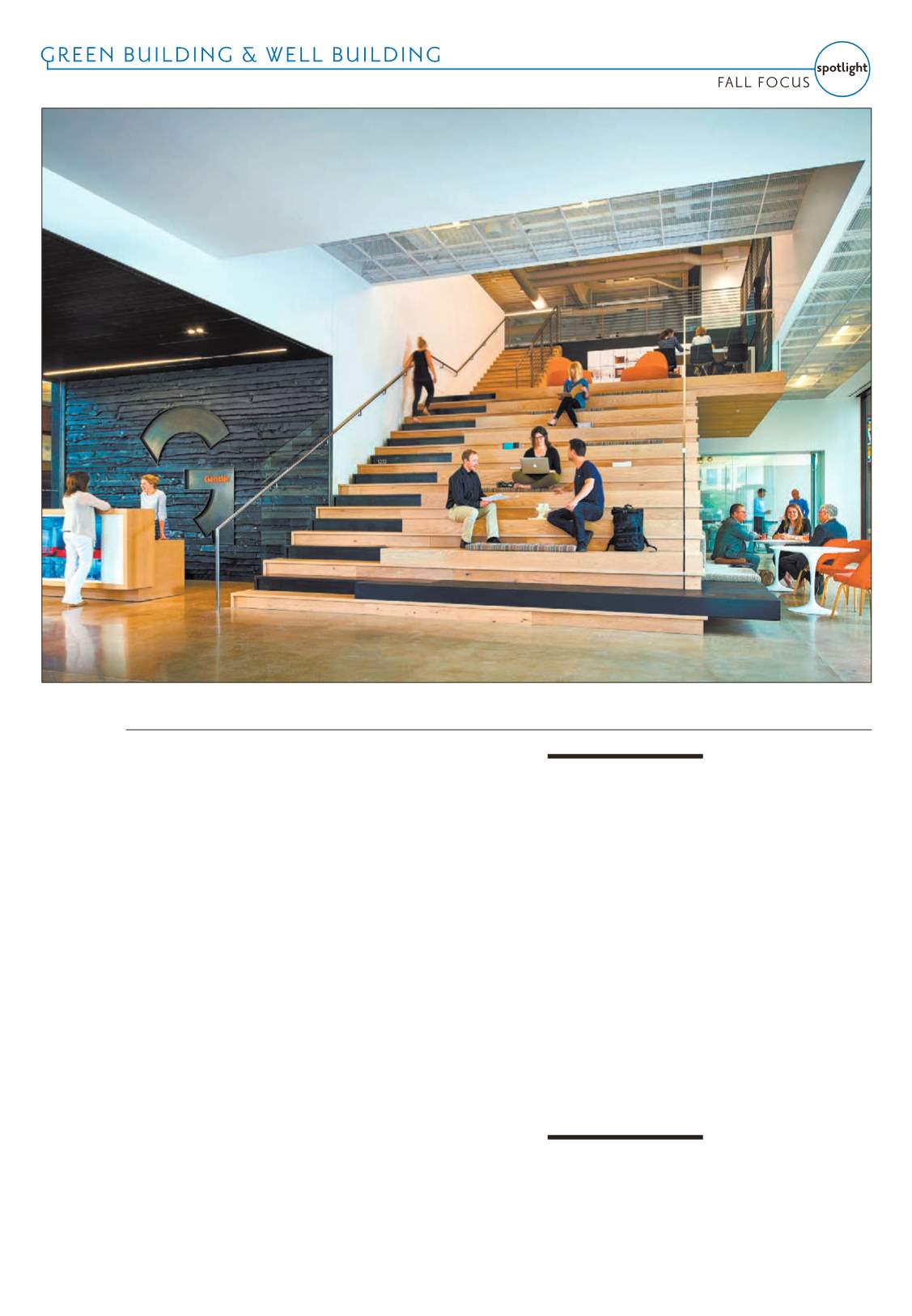
September 2-September 15, 2015
—
COLORADO REAL ESTATE JOURNAL
— Page 17B
of developing colon cancer,
a 32 percent higher risk of
endometrial cancer and a
21 percent higher risk of
lung cancer – regardless of
how much they exercised.
In another study involving a
group of men and women who
reported exercising the same
amount, each additional hour
they spent sitting was linked to
a drop in their fitness levels. In
other words, just sitting at your
desk can actually reverse the
benefits of exercise.
So, now what?
As a designer, I’m wired to
solve problems. “Can design
improve our well-being?”
There is an overwhelming
amount of evidence showing
that well designed offices can
boost productivity and most
definitely improve health
and well-being. A recent
study from the World Green
Building Council found that
a range of factors, from air
quality and lighting to views
of nature and interior layout,
can have a positive impact on
health, satisfaction and job
performance of office workers.
Gensler's 2014 Well-Being &
the Workplace research found
that employees who report that
the air in their office is “always
fresh” are 3½ times more
likely to report that their work
environment is energizing. In
addition to air quality, acoustics
and lighting, a well-designed
office also needs to be used in
the right way, so maximizing
well-being is as much about
changing behaviors as it is
about designing physical space.
Today, many of our clients
are more aware than ever of
the importance of a well-being
strategy in the workplace.
Amenities like on-site fitness
areas, shared bicycles and
even companywide fitness
competitions are now the
norm. Another key benefit
for many employers is a pet-
friendly environment. At The
Alliance Center, it’s common
to see a furry friend scurrying
around the office providing
comic relief as well as a
reported increase in moral and
stress relief.
Although humans have
evolved to become indoor
creatures, we remain hardwired
to work better in daylight. We
have an inherent need, called
biophilia, to stay connected
with nature. At The Alliance
Center, Gensler created a light-
filled space and strong visual
connections from one side of
the floor plate to the other.
Organic patterns, green walls
and tactile materials create that
strong connection to natural
phenomenon.
More important now than
ever, well-being is good
business.
Thoughtful design
interventions can pay
dividends for individuals and
for organizations as a whole.
Here are a few simple ideas:
• Bring the outdoors
in: Evidence suggests that
employees who work in
environments containing
plants experience lower levels
of stress and demonstrate
higher productivity. Studies
also indicate that there
are numerous benefits
to introducing biophilic
principles.
• Acoustics: Addressing
acoustics can positively affect
focus and memory, and reduce
stress. A Gensler study shows
70 percent of respondents said
noise is the greatest distraction
in the workplace and 80
percent said productivity would
be improved by addressing
it. White noise, absorbent
materials and careful planning
strategies can mitigate visual
and audible distractions.
• Fresh air: Gensler’s 2014
Well-Being & the Workplace
research found that employees
who report that the air in their
office is “always fresh” are 3½
times more likely to report
that their work environment is
energizing.
• Lighting: Our body
functions at its best when
subjected to a natural circadian
rhythm. Providing for
daylighting, supplemented with
controllable artificial lighting
creates an environment that
results in improved melatonin
levels and more effective rest.
• Un-tether! A well-designed
workplace is one that not
only allows workers to choose
where and when they work,
depending on the task at hand,
but also provides the right
balance of collaboration and
focus spaces. Most importantly,
these spaces shouldn’t
interfere with each other. (See
Acoustics)
• Ergonomics: Ergonomics is
not just a correct chair height
and good desk posture. It also
about creating an environment
that fits the worker and the
tasks of the workers. Sit-
to-stand desks provide an
opportunity to change posture
throughout the day as do
stand-up meeting areas and
collaboration zones. One size
does not fit all.
• Access to water and
healthy snacks: Fresh water
and nutrition are necessary
to support a healthy life.
Providing convenient access
to water stations and healthy
food options can lead to
improved productivity as
well as supporting employee
interaction and an active
environment.
• Promote activity:
Optimizing the physical
environment to promote
activity can have significant
health benefits. Taking the
stairs is often faster than
waiting for the elevator, and
it also burns twice as many
calories as walking.
• Autonomy: Whether it’s
temperature, lighting controls
or standing vs. sitting, simply
being allowed to personalize
the experience makes people
feel more at ease in a space.
• Nudge: Effective design
incorporates subtle and
sometimes not-so-subtle nudges
that suggest the choice that will
benefit people the most.
The answer is yes, thoughtful
design can improve our
well-being in the workplace.
Companies who implement
wellness strategies for their
employees may be providing
a perk today, but it is quickly
becoming the new normal. So
get out of those chairs, no one
wants to be left sitting!
Gensler’s Denver office
A well-designed
workplace is one
that not only
allows workers to
choose where and
when they work,
depending on
the task at hand,
but also provides
the right balance
of collaboration
and focus spaces.
Most importantly,
these spaces
shouldn’t interfere
with each other.


